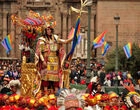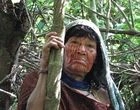
Ready to experience the wonders of Peru? Get in touch, and we’ll help you plan the adventure of a lifetime!

Ready to experience the wonders of Peru? Get in touch, and we’ll help you plan the adventure of a lifetime!

Email Consent Notice
By checking the box, you consent to PeruVisit.com collecting and processing your email address for the purpose of sending newsletters, promotional offers, and information about tours in Peru.
You acknowledge and understand that:
For full details on how we manage personal data, please refer to our Privacy Policy.


We've got something special for those seeking more than just a typical trip. Survival programs deep in the heart of the Amazon, thrilling rafting escapades down mountain rivers, challenging alpine treks in the Andes, and soaring high above on paragliders. Hit the rugged trails with mountain bikes, motorcycles, and ATVs, experience adrenaline-pumping descents on cable cars, and spend nights on floating islands made of local reed - totora. Whether you fancy jungle fishing in the Amazon or the Pacific, conquering sandy dunes in buggies or on sandboards – Peru offers a myriad of unforgettable experiences for your next getaway!

Inti Raymi stands as one of Peru's most captivating events, an immersive journey into the ambiance of the mighty Incan civilization. Every year, thousands of eager travelers flock to Cusco, eager to witness this spectacle firsthand.

Tumi – a name that resonates with the mystique of ritual ceremonies, wielded in ancient Peru and during the illustrious era of the Inca Empire. The intricate figure adorning the knife's handle is often regarded as a sacred depiction of the revered god Nylamp, a deity cherished by the Lambayeque culture.

Taking the train to Machu Picchu is more than transportation — it’s part of the adventure. From budget-friendly scenic rides to once-in-a-lifetime luxury journeys, this ultimate 2025 guide helps you choose the best train for your travel style, schedule, and experience. Discover insider tips, service comparisons, and what to expect onboard as you ride through the breathtaking Sacred Valley.

Peru never gets old—even after more than 10 trips! Natalia Volchkova, founder of PeruVisit, shares the 10 places that continue to take her breath away. From iconic sites to lesser-known wonders, this article offers a personal and vivid journey through the heart of Peru.

Peru is not only a land of ancient ruins and breathtaking landscapes but also a world-class destination for fishing enthusiasts. From the nutrient-rich waters of the Pacific Ocean to the pristine rivers and lakes of the Amazon, Peru offers an unparalleled variety of fishing experiences that will leave even the most seasoned angler in awe. Whether you dream of battling marlins in the deep blue sea or casting your line into the calm waters of the Amazon to reel in a peacock bass, Peru’s unique ecosystems promise the fishing adventure of a lifetime.

Peru’s Christmas and New Year celebrations are a vibrant blend of religious devotion, cultural artistry, and festive traditions that bring families together. From setting up intricate Nativity scenes (Nacimientos) to preparing traditional meals like Panetón, roasted turkey, and Arabic rice, the holiday season in Peru is a time for reflection, joy, and renewal.

Peru’s diverse regions offer varying climates and activities, from trekking in the Andes to exploring the Amazon rainforest. Dressing appropriately ensures you’ll stay comfortable and prepared for every adventure. This guide focuses on what to pack for the most important activities in each region, with practical Pro Tips to protect you from the elements and cultural insights to enrich your experience.

As you traverse the captivating landscapes of Peru, a land steeped in ancient cultures and breathtaking natural beauty, the prospect of selecting the perfect souvenir can be both exciting and overwhelming. Fear not, intrepid traveler, for we have curated a guide that delves into the luxurious world of Peruvian souvenirs, helping you make an informed and elegant choice that will encapsulate the essence of your journey.

What's on the Menu in Peru: From Fast Food to Haute Cuisine. Must-Try Peruvian Delicacies You Can't Miss! Peruvian cuisine boasts an exquisite blend of flavors and textures that will take your taste buds on a thrilling adventure. From the national favorites like "cuy" (guinea pig), delicious corn-based dishes, and flavorful creole soups to the more exotic and adventurous delights like "ceviche" (fresh seafood marinated in citrus juices), crispy fried piranha, and the refreshing chicha and pisco drinks, Peru offers a delectable feast for food enthusiasts. Get ready to savor the true essence of Peru through its traditional and unique gastronomic wonders!

Discover the epitome of luxury and adventure with Peru’s finest international hotel chains. From the opulent settings of Marriott and Hilton to the historical charm of Belmond, each hotel offers an unforgettable experience, whether you’re exploring the Sacred Valley, indulging in Lima’s vibrant culture, or waking up to the stunning views of Machu Picchu. These hand-picked properties blend world-class service with the beauty of Peru, ensuring your stay is as extraordinary as the destinations themselves.

Embark on a flavorful journey through Peru’s rich culinary heritage with our guide to the best culinary classes in the country. From mastering traditional dishes like ceviche and lomo saltado to learning the art of Pisco cocktails and fusion cooking, these immersive experiences offer a unique insight into the diverse food traditions of Peru. Perfect for food enthusiasts and curious travelers alike, these classes not only teach valuable cooking skills but also offer a deeper understanding of the cultural significance behind each dish. Get ready to explore the essence of Peruvian cuisine!

The stepped cross with three tiers in each quarter is called the Inca Cross, or Chakana (stairs to the sacred —from Quechua). The Chakana is a symbol of harmony in the world. The four sets of its steps unite four sets of concepts.

Nestled at the border between Peru and Bolivia, Lake Titicaca stands majestically as the world's highest navigable lake, a testament to both cultural richness and natural splendor. Among its many marvels, the floating Uros Islands emerge, offering extraordinary reed accommodations that provide a gateway to the timeless traditions of the Uros people.

The Paucartambo Festival of the Virgin of Carmen is a cultural treasure steeped in rich history and traditions embedded in the heart of Peru. Through its vibrant parade, infectious music, and unique dances, this annual celebration has successfully kept the cultural roots of the region alive while attracting visitors from around the world.

One of the most intriguing archaeological enigmas that has the potential to revolutionize our understanding of world history is Ica Black Stones. No scholar dares to explain them within the framework of existing theories of the world's development, and the scientific community is hesitant to completely reconsider its notions about the history of civilizations.

Every year in mid-June, residents of four villages in the province of Canas (Cusco) come together to perform the renewal ceremony of the Q’eswachaca Bridge. This bridge, constructed during the Inca era, stands as the last surviving suspended bridge with Incan origins, crafted entirely from ropes made of plant fibers.

Peru is home to 135 species of hummingbirds. These small birds vary in size from 5 to 21 cm, with weights ranging from 1.6 g to 20 g. Hummingbirds can reach speeds of up to 80 km/h in flight.

The story of the khipu began long before the Incas. When you immerse into the khipu, every detail is important: the spacing between the cords, the colors, the number of knots, the method used to tie each knot, and even whether the knot was tied clockwise or counter-clockwise.

The number 3 held profound significance in Incan culture, evident in various aspects of their beliefs. The Inca Cross, or Chakana, having precisely three steps on each side, symbolized the three worlds they believed in. This number extended to the sacred animals, commandments, and the purposes of human beings in Inca cosmology. It reflected a harmonious and interconnected worldview where the triad was a guiding principle shaping their spiritual and societal understanding.

The El Comercio editorial team embarked on an expedition to the site where 23 sarcophagi of the Chachapoya culture were discovered. It is presumed that these sarcophagi were created to house the mummies of children. Scientists reached this conclusion due to the small size of the sarcophagi and the discovery of stone 'toys' found nearby.

In the heart of the Amazon jungle, the most impoverished families craft their homes directly upon the water. During the torrential rains, when the river swells vigorously, these homes gracefully float, drifting not far from the shore. In the dry season, as the water levels recede, the homes gently descend to rest on the solid ground below. It's a dance of survival, a harmonious adaptation to the ever-changing rhythm of the Amazonian environment.

A Shaman is not just a healer; they are mystical artisans of remedy, wielding the power of medicinal herbs and ancient rituals to dispel ailments and ward off misfortunes. In the beliefs of the Amazonian tribes, the tangible world intricately interlaces with the ethereal realm of spirits and supernatural forces. The Shaman's quest is to delicately balance the influence of these myriad forces upon individuals, orchestrating a harmonious convergence of physical and mental well-being.

In the heart of the Amazon rainforest, the crown jewel of flora emerges - Victoria regia, the largest water lily in the world. Majestic and unparalleled, its colossal leaves span up to 2 meters in diameter, a breathtaking spectacle of nature's grandeur. These gargantuan lily pads possess an astounding resilience, bearing the weight of up to 30 kilograms with an elegance that defies their sheer size.

The crania of the majority of mummies discovered from the Paracas culture exhibit significant deformation, elongated upwards. However, the fascination with the Paracas civilization goes beyond mere cranial morphology. Remarkably, a substantial percentage (40-60%) of the skulls unearthed from their burial sites reveal variously shaped perforations, adding a layer of mystery to their ancient legacy.

In the vibrant realm of Peruvian exports, cocoa beans take center stage. Peru, renowned for its high-quality cocoa, not only produces these coveted beans but also crafts and exports chocolate bars made from pure cocoa paste. For those seeking an immersive chocolate experience, a visit to the Chocolate Museum in Cusco is an absolute delight.

Qoyllur Rit'i unfolds at the end of May to the beginning of June and spans several days. This vibrant celebration takes place at the temple nestled at the base of the Ausangate glacier. Peruvians ascend the glacier to bring back a piece of snow to the temple. People believe that this ice brings good fortune and has healing properties against illnesses.

The Aymara people, residing on the Lake Titicaca in the border regions of Peru, Bolivia, and Chile, are a fascinating community. Rooted in ancient traditions, the Aymara have preserved the legacy of their ancestors, but what truly captivates the imagination is their language.

The Puya Raimondii, an ancient giant from the bromeliad family, reigns supreme in the untamed landscapes of the Andes. Picture the spectacle – colossal inflorescences that soar to staggering heights of over 32.8 feet (10 meters) and boast a majestic diameter of 8.2 feet (2.5 meters). The Puya Raimondii, an unparalleled marvel, proudly claims the title of the plant with the world's largest inflorescence, painting a breathtaking portrait of nature's grandeur amidst the majestic peaks of the Andes.

Preparing for an Ayahuasca ceremony? Discover how to properly prepare and where to experience this ritual in Peru for a safe and meaningful journey.

The name "Chicha" encompasses a variety of alcoholic and non-alcoholic beverages crafted and consumed in Peru and several other Latin American countries. The alcohol contaent in the resulting drink can vary depending on the preparation method, but on average, it hovers around 5.5%.

In a recent investigation, scientists scrutinized elongated skulls discovered over 85 years ago in Paracas, revealing a genetic puzzle. The DNA in these ancient skulls stands apart from both humans and known humanoid species, sparking speculation about potential extraterrestrial connections.

Get in touch, and we’ll help you plan the adventure of a lifetime!